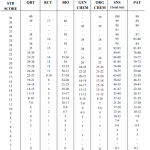When it comes to the DAT, knowing the different sections, how each works, and what’s covered is crucial. However, this can seem a little difficult for many people – which is where our experts are on hand today to help. Without further ado, we’re looking at some of the key things you need to know about the breakdown of DAT sections. We’ll also look at some helpful ideas, tips, and pointers to give you the best start with your test prep.
What we will cover?
What are the Different DAT Sections?
As part of the dental admission test, you’ll have to complete four main assessment sections during your test. These are as follows:
– Survey of Natural Sciences: The first – and largest – section of the DAT is the Survey of Natural Sciences, which assesses your knowledge of three key subtests: general chemistry (30%), organic chemistry (30%), and biology (40%). The section has 100 multiple-choice questions in total and runs for 90 minutes.
– Perceptual Ability Test: Following on from the Survey of Natural Sciences, the Perceptual Ability Test focuses on your spatial reasoning skills. The section has 90 questions in total. These are spread across six subtests: keyholes, top-front-end, angle discrimination, hole punching, cube counting, and pattern folding. The test lasts for 60 minutes.
– Reading Comprehension: The next section of the DAT – again taking 60 minutes to complete – is the Reading Comprehension section. Perhaps unsurprisingly, this section assesses reading skills, mainly in relation to natural sciences, social sciences, and humanities. The section has a total of 50 questions.
– Quantitative Reasoning: The last section of the DAT is quantitative reasoning, which measures your mathematical skills. Some key areas to brush up on for this test include general arithmetic along with algebra, geometry, and trigonometry. This is the smallest section, with just 40 questions and a run-time of 45 minutes.
In the middle of the examination, after the Perceptual Ability Test, entrants have the option to take a scheduled 30-minute break. There is also a tutorial that runs for 15-minutes prior to the examination and an optional post-test survey after the final section is complete.
- Best PAT and Biology section in the market.
- Realistic Practice Test.
- Impressive PAT problem creation and analysis tools.
- Engaging video lessons in easily digestible portions
- Excellent comprehensive study materials with visual aids, such as graphics
- Around 9000 Practice problems that closely resemble the real thing
- Ask AI feature to address your query instantly.
- Limited one-on-one coaching with expert tutors
- Offers a guarantee for a higher score
- Anki deck from Booster is quite useful for Chemistry.
- Apps for both Android and iOS with modern interfaces.
How Long Does the DAT Take in Total?
The DAT isn’t a short assessment by any means, so participants should make sure to allow a full day off to give themselves plenty of time. The actual assessed time is 255 minutes (4 hours and 15 minutes). However, with the tutorial, break, and post-test survey added in, the total time taken for the assessment is more like 5 hours and 15 minutes.
Looking at Each Section
By now, we’ve summarized each of the four main sections in the DAT. However, before you enter the examination, it’s helpful to have a more thorough understanding of each of these sections. Knowing what they include and their weighting can help strengthen your assessment strategy.
Survey of Natural Sciences – 100 Questions (54 seconds per question)
The Survey of Natural Sciences is the largest part of the DAT, both in terms of the number of questions and time taken. However, the section itself is broken down into three subsections, making it a little easier to focus your studying overall.
Biology Section – 40%
The largest aspect of the section is the biology assessment, which accounts for around 40% of the total questions. An interesting point of note is that this part of the assessment is very integrated, meaning that there’s a strong focus on how systems work together. As such, while understanding the basic principles is important, recognizing cause and effect is also vital.
Of this section, the two largest aspects are cell and molecular biology and system structure and function, which account for one quarter each. Thereafter, genetics (20%), evolution, ecology, and behaviour (11%), developmental biology (11%), and diversity of life (8%) account for the remaining 50% of the biology section.
General Chemistry – 30%
Following the biology section, the next aspect of the DAT is general chemistry, which has thirty questions in total. The section focuses heavily on the theory behind inorganic chemistry and mathematical calculations. Therefore, it’s highly important to recognize ways to integrate organic chemistry and calculations into your study.
Unlike the biology section, which has just a handful of core focal points, the general chemistry section covers numerous different concepts. As a result, there will normally be a few questions on each section instead of a substantial number on a wider topic. This does make the general chemistry section somewhat more complex to complete than the biology section in that there’s a significant number of topics you’ll need to master.
The main topics to cover in the general chemistry section include:
– Atomic and molecular structures (10%)
– Stoichiometry and general concepts (10%)
– Acids and Bases (10%)
– Solutions (10%)
– Liquids and solids (10%)
– Thermodynamics / thermochemistry (7%)
– Chemical kinetics (7%)
– Oxidation-reduction reactions (7%)
– Laboratory (7%)
– Periodic properties (7%)
– Gases (6%)
– Chemical equilibria (6%)
– Nuclear reactions (3%)
Organic Chemistry – 30%
The final section of the Survey of Natural Sciences is the organic chemistry section. This aspect of the assessment accounts for 30% of the total.
Unlike the general chemistry section, the organic chemistry section offers a little more freedom in terms of understanding; a conceptual understanding of the topic should usually be suitable.
Reactions and mechanisms are much less focused on in this section, which allows participants to use their general knowledge of organic chemistry more readily. However, it’s worth considering that the organic chemistry section may focus more heavily on critical thinking as opposed to memory alone. As such, concepts of organic chemistry may be a more valuable area to study.
Some of the main focal points of the organic chemistry section include functional groups and combinations of reactions (30%), chemical / physical properties of molecules (17%), mechanisms (17%), acid-base chemistry (10%), aromatics and bonding (10%), stereochemistry (10%), and nomenclature (6%).
Perceptual Ability Test – 90 questions (40 seconds per question)
The second section of the DAT is the perceptual ability test, which lasts for an hour and has a total of 90 questions. In line with this, you will need to be a little quicker per question to complete this section, so make sure you don’t waste time on difficult questions. If you’re unsure of something, it’s probably best to leave those until the end.
There are six subsections in the Perceptual Ability Test, each comprising fifteen questions. These are as follows:
– Keyholes / Apertures
– Top-Front-End / View Recognition.
– Angle Ranking / Angle Discrimination.
– Hole Punching / Paper Folding
– Cube Counting
– Paper Folding / 3D Form Development
The Perceptual Ability Test aims to determine an individual’s spatial visualization. This often means that the PAT section is widely considered the most difficult part of the entire dental admission test, and is often one of the areas where students fall down most significantly in scores.
Pro Tip: DATBooster (previously PAT Booster) has very high quality prep materials for PAT section. It is highly recommended for students weak in PAT section.
Common examples of questions include interpreting x-rays, casts, and fillings. These are key skills for dental practitioners to possess; as such, understanding them now may be useful regardless of just passing the test.
Reading Comprehension – 50 questions (72 seconds per question)
After the fast-paced nature of the Perceptual Ability Test, the Reading Comprehension section offers something of a slower-paced approach. In this section, students are tested on their ability to interpret scientific passages of text. This is an important aspect of the DAT overall, as it helps demonstrate that a student can extract key information and synthesize it thoroughly.
During your studies – and potentially in your future career as a dental professional – there is a good chance that you will need to be able to read and interpret scientific texts. Thus, this section intends to ascertain whether you have the necessary skills to build upon during your education as a dental student.
The questions in the Reading Comprehension section generally fall into one of six general categories. As a result, you’ll likely be asked to interpret or analyze numerous parts of the text. This gives you the freedom to work to your best analysis skills strongly. The six question types for this section include:
– Detail questions: The most common question type you’ll usually be asked is a detail question. These focus on your direct interpretation of the passage, often requiring participants to give their understanding of certain statements or sections.
– Global questions: Designs to show your overall understanding of the passage. This will often revolve around the main ideas of the text.
– Tone questions: The tone of a passage often relates directly to the objectivity of the text. In other words, this examines whether the researcher’s or author’s assumptions and statements are based on factual data or subjective beliefs.
– Function questions: Function questions look at the intended purpose or function of a particular statement or section. For example, questions might ask for possible reasonings as to why the author included a particular piece of information.
– Inference questions: Inference-type questions require the reader to analyze the text and subsequently draw conclusions based on information provided in the passage. These will often require the individual to summarize the author’s original message or make predictions not directly answered within the text.
– Title questions: One of the less common questions as part of this section relates to the title of the passage. These questions require students to create a suitable study title based on the passage provided, indicating both the understanding of the text and the participant’s ability to construct scientific essays.
Quantitative Reasoning – 40 questions (67.5 seconds per question)
The quantitative reasoning section of the DAT is based on mathematical knowledge and understanding and provides a direct insight into an individual’s ability to problem solve, which is an integral skill in and of itself with dental work.
The main focus of the quantitative reasoning section is data analysis, which accounts for 35%. Thereafter, around 25% of the section is applied mathematics, 22% is algebra, 10% is based on statistics and probability, and 8% is quantitative comparisons.
At this stage, an important point of note is that a calculator is provided during the assessment; however, it’s generally recommended not to use this as calculations may be more efficient without it.
Which Sections are Hardest?
The hardest part of the DAT is usually the Survey of Natural Sciences, with a particular focus on the biology and organic chemistry sections; for these, the 50% percentile scored just 17.5. However, the quantitative reasoning section can also scupper results with lower-than-average 50th percentile scores.
With this in mind, if you have been studying for the DAT, make sure you spend a little extra time revising these sections. It might just help bump your score up overall.
By contrast, the strongest area is usually reading comprehension, with average 50th percentile scores of around 19.5 and 90th percentile scores of 24.5. This highlights how many participants find the reading section to be much easier to score points on than the prior sections and the quantitative reason section.
Always Complete All Sections
The DAT, surprisingly enough, is a multiple-choice assessment. Thus, there’s really no reason not to have a guess for every question if you don’t know the answer. If you can make an educated guess from clues in the title, for example, there’s a decent chance you might be right – and that’s the difference between a pass mark and not.
Final Thoughts
If you have been looking to undertake the DAT, knowing about the different assessment sections can help. Indeed, while the DAT is a complex assessment that can significantly impact your dental application, making the appropriate preparations offers a simple way to increase the chances of things going to plan.
As part of your preparations, make sure you have looked at the different components of the structure to help plan your time. This simple check can help make it easier to manage your assessment as a result.




Review Summary
User Reviews
There are no reviews yet. Be the first one to write one.
Share Your Experience